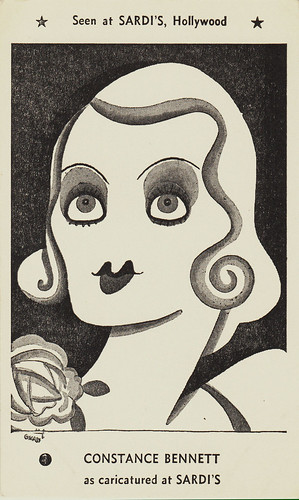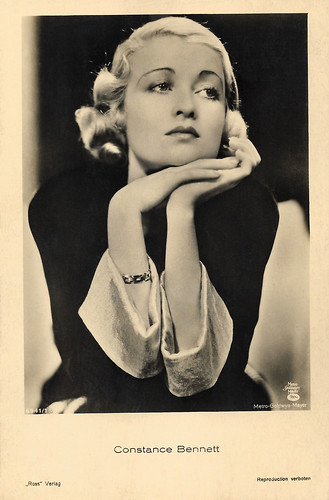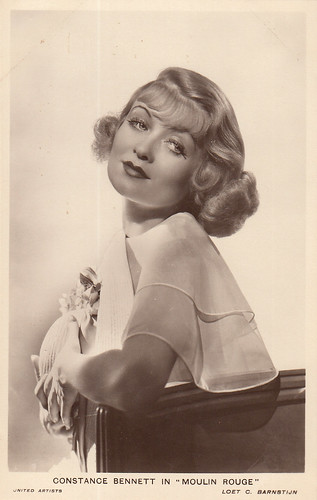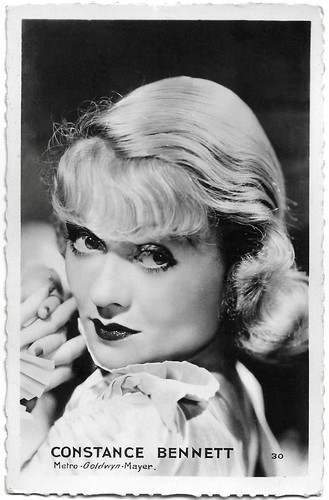
British postcard in the Cameo Series, London, no. KC 9.

American postcard published by Sardi’s. Caricature by Joe Grant. Collection: Marlene Pilaete.

British postcard in the Autograph Series, London, no. A 18.

British postcard in the Famous Cinema Star Series by Beagles, no. 218w. Photo: Warner Bros. Collection: Marlene Pilaete.
Independent, cultured, ironic, and outspoken
Constance Campbell Bennett was born in 1904 in New York City. She was the eldest of three daughters of actress Adrienne Morrison and actor Richard Bennett. Her younger sisters were actresses Joan Bennett and Barbara Bennett. All three girls attended the Chapin School in New York.
Hal Erickson at AllMovie: "Though her father did everything he could to discourage her from pursuing an acting career, Constance was willful and rebellious almost from the moment of her birth."
After some time spent in a convent, Bennett went into the family business. Independent, cultured, ironic, and outspoken, Constance, the first Bennett sister to enter motion pictures, appeared in New York-produced silent films before a meeting with Samuel Goldwyn led to her Hollywood debut in Cytherea (George Fitzmaurice, 1924).
Hal Erickson: "She treated her silent-film career as a lark, but along the way she developed a superb sense of comic timing and an instinctive gift for heavy dramatics." She abandoned her burgeoning career in silents for marriage to Philip Plant in 1925 but resumed her film career after their divorce.
With the advent of talking pictures, and with her delicate blonde features and glamorous fashion style, she quickly became a popular film star. In the early 1930s, Bennett was frequently among the top actresses named in audience popularity and box-office polls. The hit Common Clay (Victor Fleming, 1930) launched her in a series of loose lady and unwed mother roles.
For a short time, she was the highest-paid actress in Hollywood. So successful was Bennett during this time, that RKO, Bennett's home studio at the time, controlled the careers of actresses Ann Harding and Helen Twelvetrees in a similar manner, hoping to duplicate Bennett's success.
In 1931, a short-lived contract with Metro-Goldwyn-Mayer earned her $300,000 for two films which included The Easiest Way (Jack Conway, 1931) and made her one of the highest-paid stars in Hollywood. Warner Brothers paid her the all-time high salary of $30,000 a week for Bought! (Archie Mayo, 1931). Richard Bennett, her father, was also cast in this film.
The next year she moved to RKO, where she acted in What Price Hollywood? (George Cukor, 1932), an ironic and at the same time tragic behind-the-scenes looks at the old Hollywood studio system, in which she portrayed waitress Mary Evans, who becomes a movie star. Lowell Sherman co-starred as the film director who discovers her, and Neil Hamilton was the wealthy playboy she marries. It was a critical and box office hit.
The film Morning Glory (Lowell Sherman, 1933) had been written with Bennett in mind for the lead role, but producer Pandro S. Berman gave the role to Katharine Hepburn, who won an Academy Award for her performance. Bennett next showed her versatility in the likes of Our Betters (George Cukor, 1933), writer/director Gregory La Cava's Bed of Roses (1933) with Joel McCrea, and After Tonight (George Archainbaud, 1933) in which she co-starred with future husband Gilbert Roland.
Next, she appeared in The Affairs of Cellini (Gregory La Cava, 1934), After Office Hours (Robert Z. Leonard, 1935) with Clark Gable, and the original Topper (Norman Z. McLeod, 1937), in a career standout as Marian Kerby opposite Cary Grant. She repeated the role in the sequel, Topper Takes a Trip (Norman Z. McLeod, 1939). Then followed the ultimate madcap family comedy Merrily We Live (Norman Z. McLeod, 1938) and Two-Faced Woman (George Cukor, 1941) in which she supported Greta Garbo.

French postcard in the Les Vedettes de Cinéma series by A.N., Paris, no. 222. Photo: Metro-Goldwyn Production.

German postcard by Ross Verlag, Berlin, no. 904/1, 1925-1926. Photo: Transocean Film Co., Berlin.

German postcard by Ross Verlag, Berlin, no. 6941/1, 1931-1932. Photo: Metro-Goldwyn-Mayer.

Italian postcard by B. F. F. Edit., no. 2708. Collection: Marlene Pilaete. Constance Bennett in The Affairs of Cellini (Gregory La Cava, 1934).
Marrying a well-known playboy of questionable royal lineage
By the 1940s, Constance Bennett was working less frequently in films but was in demand in both radio and theatre. Her stage acting debut was Noël Coward's 'Easy Virtue' (1940). She had her own program, 'Constance Bennett Calls on You', on ABC radio in 1945-1946. Shrewd investments had made her a wealthy woman, and she founded a cosmetics and clothing company.
Bennett was married five times and had three children. In 1921, Bennett eloped with Chester Hirst Moorehead, a student at the University of Virginia. Bennett was 16 at the time and her parents were opposed to their marriage solely on account of their youth. The marriage was annulled in 1923.
Bennett's next serious relationship was with millionaire socialite Philip Morgan Plant. Her parents planned a cruise to Europe, taking Constance with them, to separate the couple. As the ship was preparing to leave port, however, the Bennetts saw Plant and his parents boarding, too. A contemporary newspaper article reported, "Now the little beauty and the heir to all the Plant millions were assured a week of the cosy intimacy which an ocean liner affords." In 1925, the two eloped and were married and they divorced in a French court in 1929.
In 1932, Bennett returned from Europe with a three-year-old child, whom she claimed to have adopted and named Peter Bennett Plant (1929). In 1942, however, during a battle over a large trust fund established to benefit any descendants of her former husband, Bennett announced that her adopted son actually was her natural child by Plant, born after the divorce and kept hidden to ensure that the child's biological father did not get custody. During the court hearings, the actress told her former mother-in-law and her husband's widow that "if she got to the witness stand she would give a complete account of her life with Plant." The matter was settled out of court.
In 1931, Bennett made headlines when she married one of Gloria Swanson's former husbands, Henri le Bailly, the Marquis de La Coudraye de La Falaise, a well-known playboy of questionable royal lineage. She and de la Falaise founded Bennett Pictures Corp. and co-produced two films which were the last filmed in Hollywood in the two-strip Technicolor process, Legong: Dance of the Virgins (Henri de La Falaise, 1935) filmed in Bali, and Kilou the Killer Tiger (Henri de La Falaise, 1936), filmed in Indochina. They were divorced in Reno, Nevada in 1940.
Bennett's fourth marriage was to actor Gilbert Roland. They were married in 1941 and had two daughters, Lorinda "Lynda" (1938) and Christina "Gyl" (1941). They divorced in 1946, with Bennett winning custody of their children. Later that year, Bennett married for the fifth and final time to US Air Force Colonel (later Brigadier General) John Theron Coulter. After her marriage, she concentrated her efforts on providing relief entertainment to US troops still stationed in Europe, winning military honors for her services. Bennett and Coulter remained married until her death in 1965.
In 1947, Bennett had a major supporting role in The Unsuspected (Michael Curtiz, 1947), in which she played Jane Moynihan, the program director who helps prove that radio host Victor Grandison (Claude Rains) is guilty of murder. In 1957–1958, she toured the United States in the title role of 'Auntie Mame', and in 1945-1946, she hosted 'The Constance Bennett Show' on ABC Radio.
In the 1950s, As Young as You Feel (Harmon Jones, 1951) found her playing opposite a young Marilyn Monroe, and she played herself in a cameo in It Should Happen to You (George Cukor, 1954). Bennett made her final screen appearance in Madame X (David Lowell Rich, 1966) as the blackmailing mother-in-law of Lana Turner.
Shortly after the filming of Madame X was completed, Bennett collapsed and died from a cerebral hemorrhage at the age of 60. In recognition of her military contributions, and as the wife of John Theron Coulter, who had achieved the rank of brigadier general, she was buried in Arlington National Cemetery. Coulter died in 1995 and was buried with her. Bennett has a motion pictures star on the Hollywood Walk of Fame for her contributions to the film industry. Her star is located at 6250 Hollywood Boulevard, a short distance from the star of her sister, Joan.

Dutch postcard by Loet C. Barnstijn. Photo: United Artists / 20th Century. Constance Bennett in Moulin Rouge (Sidney Lanfield, 1934).

Dutch postcard by Loet G. Barnstijn. Photo: United Artists / 20th Century. Constance Bennett in Moulin Rouge (Sidney Lanfield, 1934). Collection: Marlene Pilaete.

Spanish postcard in the Estrellas del cine series by Editorial Grafica, Barcelona, no. 112. Photo: Metro-Goldwyn-Mayer.

British postcard.

French postcard by Edit. Chantal, Rueil (S.-O.), no. 30. Photo: Metro-Goldwyn-Mayer.

Italian postcard by Rizzoli & C. Milano, 1938. Photo: 20th Century. Constance Bennett in The Affairs of Cellini (Gregory La Cava, 1934).

British postcard in the Picturegoer Series, London, no. W. 482. Photo: Warner.
Sources: Hal Erickson (AllMovie), Rod Crawford (IMDb), Wikipedia, and IMDb.
No comments:
Post a Comment